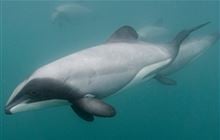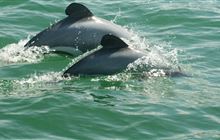More measures to protect Hector’s dolphins
Archived content: This media release was accurate on the date of publication.
Introduction
Work to improve protection of the nationally endangered Hector’s dolphin will accelerate after five were accidentally killed in a fishing net off Banks Peninsula.Date: 20 March 2018 Source: Office of the Minister of Conservation and the Minister for Primary Industries
Fisheries Minister Stuart Nash and Conservation Minister Eugenie Sage are accelerating work to improve protection of the nationally endangered Hector’s dolphin, after five were accidentally killed in a fishing net off Banks Peninsula.
The dolphins were trapped in a commercial set net about six nautical miles north of Banks Peninsula on 17 February. The fisherman reported the incident to Fisheries Inshore New Zealand (FINZ) and to the Ministry for Primary Industries (MPI).
Mr Nash and Ms Sage have identified a number of areas where more work needs to be done, and have asked for advice on whether changes can be made to some fishing practices in the short-term.
The range of options includes:
- prioritising the development of a new Threat Management Plan for Māui and Hector’s dolphins
- reviewing the use of set nets in a bid to reduce or phase out their use
- considering extending the ban on set nets in the Banks Peninsula Marine Mammal Sanctuary further offshore
- encouraging voluntary closures of certain fisheries to set nets such as those recently put in place by commercial set netters to protect the hoihō/yellow eyed penguin off Southland.
- the role of observers and camera coverage on fishing boats.
“The deaths of these dolphins is distressing,” Mr Nash said.
“The fisherman did the right thing by coming forward to report the catch, as legally required. There were no observers or cameras on his boat. The Chief Executive of FINZ advises me the fisherman deeply regrets the capture and has now decided to stop set netting in the area. I am also advised he appears to have been fishing outside the area closed to set netting, although MPI compliance staff are still assessing the incident.
Mr Nash and Ms Sage are overseeing a review of the Threat Management Plan (TMP) for Hector’s and Māui dolphins, which has been in place since 2008. The review will consider longer-term measures to better protect the dolphins from the risks of set netting and deaths caused by other human activity.
“In light of this capture, I have asked officials to prioritise the development of a new plan. A revised TMP would include public and stakeholder consultation,” says Mr Nash.
“There are an estimated 9,000 Hector’s dolphins off the South Island’s east coast, and they are a sub-group of the wider South Island population of 15,000 mammals. Fisheries officials believe the east coast population may be declining,” says Mr Nash.
“The needless death of five dolphins in one set net underlines the ongoing problem of set net use in places where highly endangered species, like Hector’s and Māui dolphins live, and the indiscriminate nature of set nets as a fishing method,” Ms Sage said.
“As well as Hector’s and Māui dolphins, set nets catch and drown seabirds such as hoihō (yellow-eyed penguin), little blue and Fiordland crested penguins, shags, shearwaters and terns.
“Areas around Banks Peninsula and on the North Island’s West Coast have been closed to set nets to protect Hector’s and Māui dolphins, but dolphins and seabirds continue to get caught and die in set nets.
“Having a serious look at how to best phase out these near invisible and deadly mono-filament gill nets is long overdue. Fishers can use other methods to catch target species such as butterfish, mullet, rig, and school shark.
“Hector’s dolphins live close to the coast making them highly vulnerable to being caught in set nets. Official records show 188 Hector’s and Māui dolphin are known to have been killed in set nets since 1973.
“New Zealand could follow the example of American states such as California and North Carolina which have banned commercial set nets to protect endangered seabirds, marine mammals and turtles. South Australia has done the same to protect the Australasian sea lion, as has Finland for the Saimaa ringed seal,” Ms Sage said.
Contact
For media enquiries contact:
Email: media@doc.govt.nz


